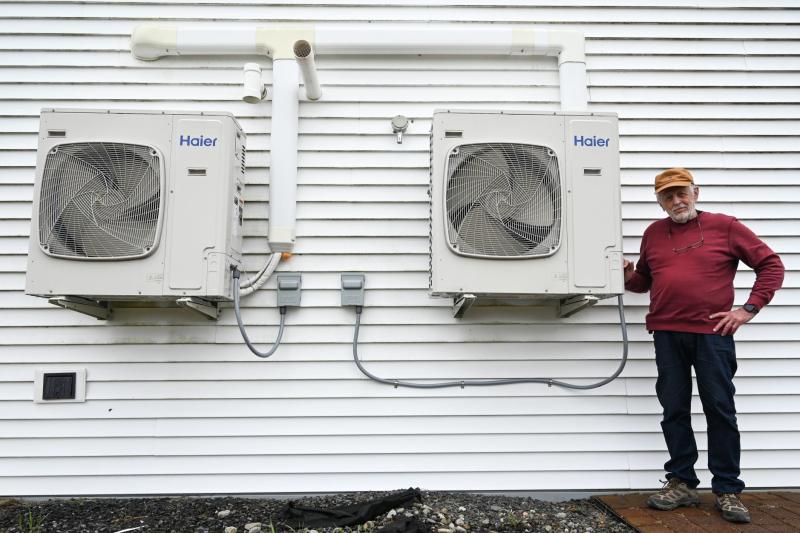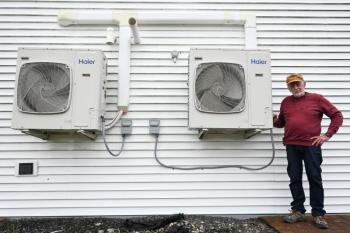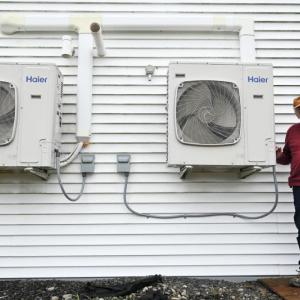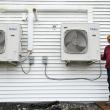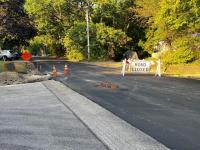Maine’s heat pump boom has been promising for rural workforce development. Can it last?
The sputtered drone of a vacuum pump filled the former milking barn that now houses Kennebec Valley Community College’s heat pump lab. Instructor Dave Whittemore, who held the yellow vacuum in one hand and displayed an app tracking atmospheric pressure on his phone in the other, explained in a raised voice how to do an “evacuation,” ridding the heat pump of air and moisture to avoid malfunctions down the road.
“The longevity of the equipment is important,” said Whittemore, who teaches students how to install the increasingly popular electric heating and cooling units. “If it’s not done right, then it’s going to fail prematurely. And that’s the biggest reason that I personally try to keep up with industry best standards and I pass that on to my students.”
Six years ago, Gov. Janet Mills traveled to the college to sign a bill aimed at transforming Maine’s market for heat pumps, an environmentally friendly alternative to oil furnaces and gas boilers, and set a goal of installing 100,000 units by 2025.
The state, now a national leader for heat pump adoption, met that goal two years ahead of schedule, and Mills once again traveled to the rural Somerset County campus to announce a new target: another 175,000 heat pumps by 2027.
Maine needs skilled workers to reach this goal, demanding training initiatives from all corners of the state to build HVAC, refrigerant and electrical knowledge in the clean energy workforce. Without a strong pipeline, the state risks delays in reaching its heat pump target, putting its climate goals at risk.
So far, rural counties have seen some of the fastest rates of clean energy worker growth, according to state data. In Somerset County, where KVCC is located, the number of clean energy workers has grown by 44% since 2020.
As part of this push, the community college launched a high-tech heat pump training lab in 2021 and has trained over 300 students. The initiative is one of many clean energy programs the school offers as part of a broader, state-supported effort to meet Maine’s goal of reaching 30,000 clean energy jobs by 2030.
Efficiency Maine, a quasi-governmental agency that oversees the state’s energy efficiency programs, has invested more than $400,000 in installation and weatherization training programs at KVCC and supports 29 similar programs at other institutions each year.
Another key piece of state support comes through the Governor’s Energy Office’s Clean Energy Partnership, which has awarded nearly $5 million in grants for clean energy training and apprenticeship programs across the state since 2022 and has seen over 3,500 participants. Businesses have also developed their own on-the-job training programs to help meet demand.
But the state still faces a daunting challenge: It must employ more than 14,000 new workers to reach its goal of 30,000 clean energy jobs by the end of the decade. Between 2019 and 2023, the number of workers in the field grew by less than a thousand.
While the state says it remains dedicated to this goal, some in the industry worry federal funding cuts and tariffs could create challenges for the workforce development pipeline.
Efforts underway in many corners of Maine
Heat pumps have emerged as a pillar of Maine’s clean energy strategy: The units can reduce carbon dioxide emissions between 38% and 53% compared to a gas furnace, according to a 2022 study in the academic journal Energy Policy, and have been touted as a way to reduce energy costs.
Rural areas have historically spent more on energy bills and participated less in residential energy and efficiency financing and rebate programs to lower costs, according to a state report from 2023. To help rural Mainers overcome geographic barriers in accessing cost-lowering energy initiatives, the state must bolster its rural workforce, according to a 2018 study the Island Institute produced in partnership with the Governor’s Energy Office.
The demand for cleaner energy has grown not only in response to the state’s climate goals, but also as Maine’s electricity costs rise. A Maine Monitor analysis showed that electricity costs increased at the third-highest rate in the U.S. between 2014 and 2024.
A Maine Monitor analysis of 2023 U.S. Department of Energy and Bureau of Labor Statistics data prepared for E2 shows that two-thirds of the state’s clean energy jobs were in the energy efficiency sector, while about a fifth of jobs were in renewables.
Workforce development has become a priority for the state as the clean energy industry grows, said Tagwongo Obomsawin, the program manager for the state’s Clean Energy Partnership, noting that it can provide good paying jobs for Mainers and reduce energy costs.
“Employers are definitely a really important part of the picture, but we don’t want to leave out anyone,” Obomsawin said. “We recognize that training providers, academia, state government, organized labor and industry all have a role to play in making sure that we have a robust system that supports people in finding job opportunities, getting access to training and localizing the benefits of the energy transition.”
Heat pump training is just one of several clean energy programs offered through the Maine Community College System, which includes KVCC. The system works with industry and state leaders to grow the workforce. The network of schools also trains students in electric vehicle maintenance, fiber optics, aquaculture and more.
Dan Belyea, the system’s chief workforce development officer, said short-term training and scholarship funding are centered on needs that arise in the industry, which the schools gauge by looking at labor market data and talking to employers. Programs that are highest in demand tend to include electrical and heat pump training, Belyea said.
In 2022, KVCC hoped to use a nearly $250,000 grant from the Clean Energy Partnership to offer programs on electric vehicles and NABCEP solar photovoltaic installation. But trouble finding instructors and low interest among students made it difficult to launch.
Instead, KVCC doubled down on energy efficiency. It launched a building science program with the funding last fall, which had five students, two of whom were able to complete the certification.
Other clean energy workforce initiatives have popped up across the state. Some employers run their own heat pump or solar installation training labs, and several adult education programs and nonprofits also offer classes designed to help people move into the industry.
passivhausMAINE, a Freeport-based organization, received $180,000 in Clean Energy Partnership money in 2022 to host training programs on the state’s energy code. The company ran 29 trainings across the state, from Portland to Presque Isle.
Naomi Beal, executive director of passivhausMAINE, noted that getting enough students to attend the training was easier in areas like Portland, but trickier in more rural areas.
“I always feel like it’s very important to consider when going into Greenfield or Machiasport or wherever that there are just not that many people.… So if we get five people showing up, that’s probably statistically way more interest than (a larger number of attendees) down in Portland,” Beal said. “We just try to be patient and persistent with the smaller towns and the smaller attendance.”
A need for more collaboration
In Freeport, Scott Libby, the owner of Royal River Heat Pumps, walked through his training center as he explained that all his workers go through heat pump training that starts with the basics, regardless of experience, to ensure each worker is equipped to handle the job.
“A lot of these heat pumps have 12-year warranties,” Libby said. “That’s 4,380 days. The most important day is Day 1. It needs to be installed properly.”
Libby, who has worked with the U.S. Department of Energy on workforce development and sits on a new energy efficiency workforce subcommittee being developed by the Governor’s Energy Office, said he’s aware of a number of different workforce development initiatives but that it’s difficult to comprehend how they all work together.
He said some forms of programming aren’t sufficient for what’s actually needed in the field: Students who sit through a six-week or six-month program that teaches the basics of how heat pumps work may come out with little to no hands-on experience with a power tool or climbing a ladder.
Libby emphasized the need for more collaboration between different workforce development efforts and a more systematic approach, with quality checks in place. He suggested putting more thought into designing industrial arts and home economics programs in middle and high schools to introduce students to different career pathways early on.
He also said more stringent licensing requirements could help with the quality of workers moving into the field. As it stands, there is no specific licensing required to install heat pumps in Maine, though workers need an Environmental Protection Agency Section 608 license to deal with the refrigerant used inside the unit and an electrical license to complete the wiring.
He acknowledged that new regulation could “cripple” workforce development efforts but said the move is imperative to control the level of training workers receive and make sure everyone is qualified to install heat pumps. There are hundreds of contractors listed as qualified heat pump installers on Efficiency Maine’s website, a list he said in his opinion should be much shorter.
Uncertainties lie ahead
At KVCC’s heat pump lab, Whittemore gestured at eight heat pumps mounted on prop walls used for training, listing the types of new units he hopes to get soon – ideally through donations from companies who have given units in the past.
Regulatory changes to refrigerants that went into effect this year mean the school needs to replace the heat pumps it uses to train students.
“Most of the procedures with the new refrigerants are the same, it’s just that we can’t put this new refrigerant in these existing heat pumps,” he said. “So I’ve got to get eight new heat pumps.”
The broader challenge he sees for the industry is tariffs, which he fears could lead to higher equipment prices and lower demand. This, in turn, could mean a lower need for workers.
“I think that’s going to slow this down,” he said.
Maine has two years to reach its goal of installing 275,000 heat pumps and five years to reach its goal of 30,000 clean energy jobs. But uncertainties in building Maine’s workforce lie ahead.
The Clean Energy Partnership Project, which has funded many of the state’s clean energy workforce development programs, typically announces new grants in the summer, but the Governor’s Energy Office stopped short of committing to another round of funding this year.
“We can’t predict the future, but the existing programs that we have will continue on for at least another couple of years,” Obomsawin said.
She said a partnership the Energy Office has with the Department of Labor to provide career navigation services will continue into 2026, as will workforce development programs that received funding and are already operational. But she cautioned that it is still too early to know what impact policy changes at the federal level will have on the clean energy sector.
Efficiency Maine said that the state is still on track to achieve its heat pump goals – at least for now. Executive Director Michael Stoddard said that the heat pump rebate program has funding from the Electric Utility Conservation Program and the Regional Greenhouse Gas Initiative for at least the next three years.
However, some smaller initiatives, such as a revolving loan to help Mainers buy new heat pump systems, face uncertainty as the federal grants funding the project are in flux.
Libby, of Royal River Heat Pumps, has 40 years of HVAC industry experience and said funding uncertainty will make it a challenge to reach the state’s heat pump goal.
“I think it’s definitely going to be harder,” Libby said. “I mean, I’m not ready to give up on it yet. I don’t think anybody is ready to give up on it.”
This story was originally published by The Maine Monitor, a nonprofit civic news organization. To get regular coverage from The Monitor, sign up for a free Monitor newsletter here.

